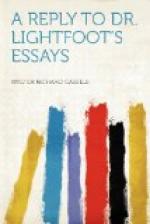“That this (Sychar) cannot be the large, ancient Sikhem, which, at the time when the Gospel was written, was probably already generally called Neapolis in Greek writings, has been already stated; it is the place still called with an altered Arabic name Al ’Askar, east of Naplus. It is indeed difficult to prove that Sychar could stand for Sikhem, either through change of pronunciation, or for any other reason, and the addition [Greek: legomene] does not indicate, here any more than in xi. 54, so large and generally known a town as Sikhem. or Flavia Neapolis.” [33:3]
Mr. Sanday, [33:4] of whose able work Dr. Lightfoot directly speaks, says:—
“The name Sychar is not the common one, Sichem, but is a mock title (=’liar’ or ‘drunkard’) that was given to the town by the Jews. [33:5] This is a clear reminiscence of the vernacular that the Apostle spoke in his youth, and is a strong touch of nature. It is not quite certain that the name Sychar has this force, but the hypothesis is in itself more likely than, &c.... It is not, however, by any means improbable that Sychar may represent, not Sichem, but the modern village Askar, which is somewhat nearer to Jacob’s Well.”
To quote one of the latest “travellers and apologists,” Dr. Farrar says: “From what the name Sychar is derived is uncertain. The word [Greek: legomenos] in St. John seems to imply a sobriquet. It may be ‘a lie,’ ‘drunken,’ or ‘a sepulchre.’ Sychar may possibly have been a village nearer the well than Sichem, on the site of the village now called El Askar.” [34:1] As Dr. Lightfoot specially mentions Neubauer, his opinion may be substantially given in a single sentence: “La Mischna mentionne un endroit appele ‘la plaine d’En-Sokher,’ qui est peut-etre le Sychar de l’Evangile.” He had a few lines before said: “Il est donc plus logique de ne pas identifier Sychar avec Sichem.” [34:2] Now, with regard to all these theories, and especially in so far as they connect Sychar with El Askar, let me quote a few more words in conclusion, from a “common source of information:”—




